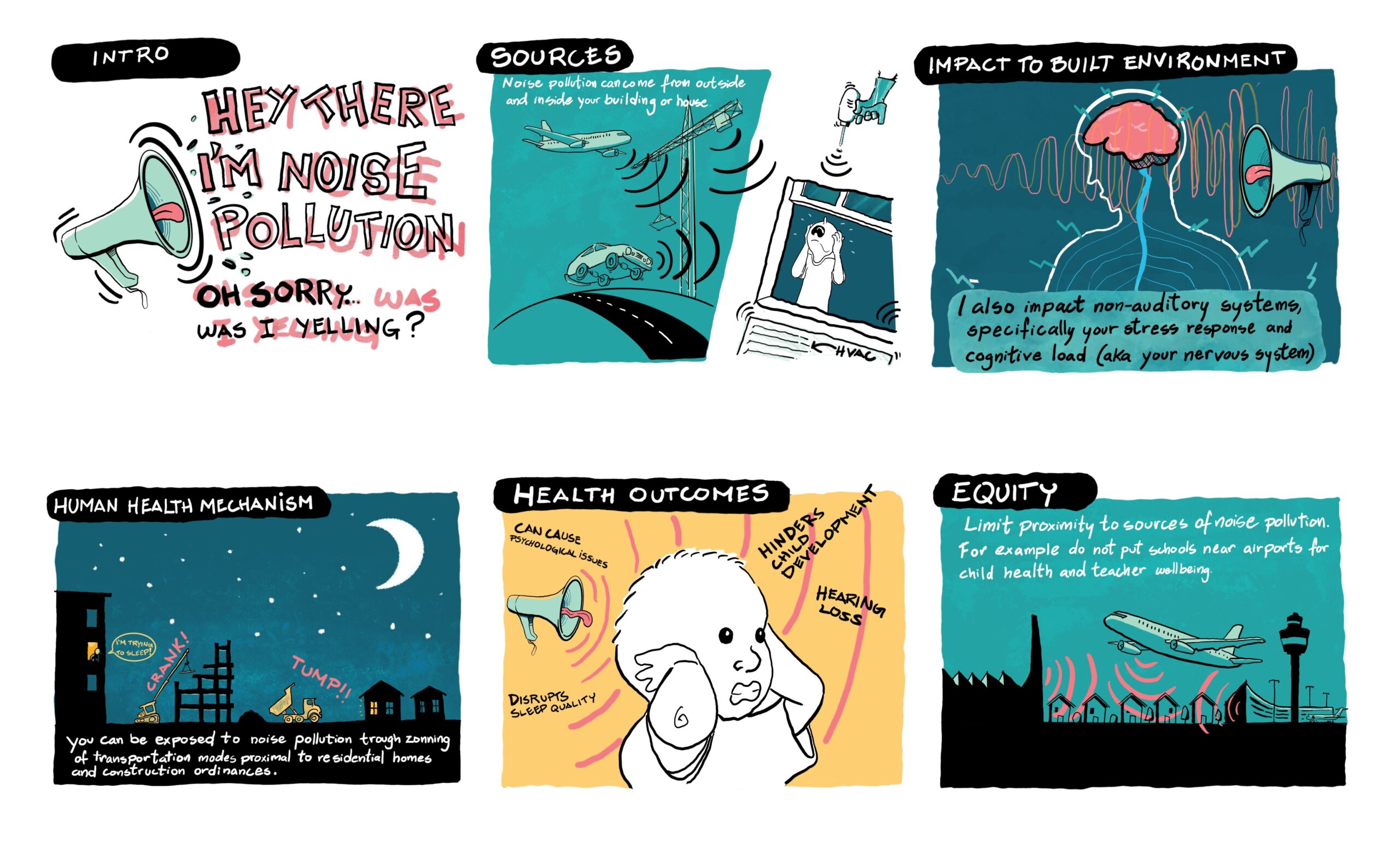
Click here for caption
Transcript: HEY THERE, I’M NOISE POLLUTION. OH SORRY WAS I YELLING?! I am any unwanted and disturbing sounds that interfere with normal activities such as sleeping, conversation, or disrupts or diminishes anyone’s quality of life. While many may consider noise to be just an annoyance, I can lead to detrimental health effects. I can come from all sorts of things, from transportation, such as trains, planes, and automobiles, to construction activities happening right next-door to your home or office. In addition, I can come directly from noises inside your building, such as from an HVAC system or from your noisy coworker. While it might seem like you are only exposed to me through auditory systems (what we hear), I also impact non-auditory systems, specifically your stress response and cognitive load (aka your nervous system). Because I expose your auditory and nervous system to undue stress, I can also cause a variety of auditory and non-auditory health outcomes. I can cause temporary/permanent hearing loss, sleep disturbance, child development, and mental distress. And the constant activation of the nervous system’s stress response increases oxidative stress and inflammation, which can lead to obesity, CVD, high blood pressure, and diabetes. The built environment can dictate how you are exposed to noise pollution through zoning of transportation modes proximal to residential homes and construction ordinances (eg, permitted working hours). Building interiors can also impact acute noise pollution through programming of interior spaces. Proximity to sources of pollution, such as airports and heavy industrial sites, has been a contributing factor to enduring disparities in health for communities of color and low-income communities in the U.S. Designers can help reduce these disparities by protecting occupants from noise pollution both from the outside as well as the interior, such as noisy HVAC and mechanical systems.
Definition
Noise pollution, technically known as acoustic pollution, refers to the presence of environmental noise that exceeds acceptable levels, interferes with normal activities, and causes annoyance or adverse health effects. It is typically measured in decibels (dB) and encompasses a range of sounds from various sources, including transportation, industrial processes, and urban activities, which can lead to cognitive and physiological disturbances.
Human Health Mechanism
Prolonged exposure to noise pollution poses significant health risks, including sleep disturbances, stress-related ailments like cardiovascular diseases and high blood pressure, speech interference, hearing loss, and cognitive impairment affecting concentration and memory. Children under 15 years old are especially sensitive to noisy conditions because they are still developing language skills. Noise pollution, extending beyond mere annoyance, highlights the need to address this environmental hazard for the sake of public health and well-being.
Indicator Measurement
Calculated by the US Department of Transportation (DOT) as the average 24-hour noise decibel caused by combination of proximity to roadway vehicular traffic, freight and passenger rail, and aviation/airport.
Source of Exposures
Noise pollution can come from a variety of outdoor and indoor sources, including road traffic, airplanes, construction, manufacturing processes, and heating and air conditioning units.
Related Health Outcomes & Exposures
Traffic Proximity, Cardiovascular Disease, High Blood Pressure, Sleep Deprivation
References
Click here for References
- Noise Pollution Data Source: US DOT. National Transportation Noise in the U.S. Data Year 2018. Accessed April 2023. https://maps.dot.gov/BTS/NationalTransportationNoiseMap/
- Eco-Healthy Child Care. Noise Pollution. Children’s Environmental Health Network. 2010. Accessed October 17, 2023. https://health.ucdavis.edu/mindinstitute/resources/resources_pdf/Noise_Pollution_7_14.pdf
- Eitland E, Klingensmith L, MacNaughton P, et al. Schools For Health. 2017. Accessed October 19, 2023. https://forhealth.org/Harvard.Schools_For_Health.Foundations_for_Student_Success.pdf.
- Hammer MS, Swinburn TK, Neitzel RL. Environmental noise pollution in the United States: developing an effective public health response. Environ Health Perspect. 2014;122(2):115-119. doi:10.1289/ehp.1307272
- Jafari MJ, Khosrowabadi R, Khodakarim S, Mohammadian F. The effect of noise exposure on cognitive performance and Brain Activity Patterns. Open access Macedonian journal of medical sciences. August 30, 2019. Accessed October 13, 2023. https://www.ncbi.nlm.nih.gov/pmc/articles/PMC6901841/
- Perkins&Will. Healthy Schools by Design. Published April 18, 2023. Accessed October 19, 2023. https://issuu.com/perkinswill/docs/hsbd_2023_ee
- US Environmental Protection Agency (US EPA). Clean Air Act Title IV – Noise Pollution. Published June 3, 2015. Accessed October 18, 2023. https://www.epa.gov/clean-air-act-overview/clean-air-act-title-iv-noise-pollution
